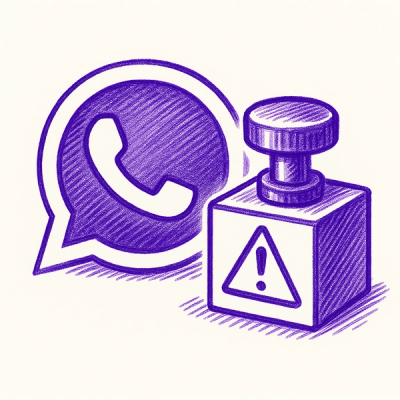
Research
/Security News
Malicious npm Packages Target WhatsApp Developers with Remote Kill Switch
Two npm packages masquerading as WhatsApp developer libraries include a kill switch that deletes all files if the phone number isn’t whitelisted.
Send notifications to slack channel with supporting attachments and fields
pip install slack-notifications
import os
import slack_notifications as slack
slack.ACCESS_TOKEN = 'xxx'
slack.send_notify('channel-name', username='Bot', text='@channel This is test message')
or
import os
from slack_notifications import Slack
slack = Slack('<token>')
slack.send_notify('channel-name', username='Bot', text='@channel This is test message')
import os
from slack_notifications import Slack, Attachment
slack = Slack('<token>')
message = slack.send_notify('channel-name', username='Bot', text='@channel This is test message')
message.text = 'This is test message'
message.update()
message.add_reaction('<name>')
message.remove_reaction('<name>')
message.upload_file('./test.yml', filetype='yaml')
message.attachments.append(
Attachment(
title='Attachment title',
pretext='Attachment pretext',
text='Attachment text',
footer='Attachment footer',
color='green',
),
)
message.update()
import os
import slack_notifications as slack
slack.ACCESS_TOKEN = 'xxx'
attachment = slack.Attachment(
title='Attachment title',
pretext='Attachment pretext',
text='Attachment text',
footer='Attachment footer',
color='green',
)
slack.send_notify('channel-name', username='Bot', text='@channel This is test message', attachments=[attachment])
See program API
import slack_notifications as slack
slack.ACCESS_TOKEN = 'xxx'
attachment = slack.Attachment(
title='Attachment title',
pretext='Attachment pretext',
text='Attachment text',
footer='Attachment footer',
fields=[
slack.Attachment.Field(
title='Field title',
value='Field value',
),
],
color='green',
)
slack.send_notify('channel-name', username='Bot', text='@channel This is test message', attachments=[attachment])
import slack_notifications as slack
slack.ACCESS_TOKEN = 'xxx'
block = slack.SimpleTextBlock(
'Text example',
fields=[
slack.SimpleTextBlock.Field(
'Text field',
),
slack.SimpleTextBlock.Field(
'Text field',
emoji=True,
),
],
)
slack.send_notify('channel-name', username='Bot', text='@channel This is test message', blocks=[block])
import slack_notifications as slack
slack.ACCESS_TOKEN = 'xxx'
block = slack.ActionsBlock(
elements=[
slack.ButtonBlock(
'Yes',
action_id='action1',
value='some_data1',
style='primary'
),
slack.ButtonBlock(
'No',
action_id='action2',
value='some_data2',
style='danger'
),
],
)
slack.send_notify('channel-name', username='Bot', text='@channel This is test message', blocks=[block])
import slack_notifications as slack
block = slack.SimpleTextBlock(
'Text example',
fields=[
slack.SimpleTextBlock.Field(
slack.mrkdwn.bold('Text field'),
),
slack.SimpleTextBlock.Field(
slack.mrkdwn.italic('Text field'),
emoji=True,
),
],
)
import os
import slack_notifications.mattermost as mattermost
mattermost.ACCESS_TOKEN = 'xxx'
mattermost.BASE_URL_ENV_NAME = 'http://your-mattermost-url.com/api/v4'
mattermost.TEAM_ID_ENV_NAME = 'xxx'
mattermost.send_notify('channel-name', username='Bot', text='@channel This is test message')
or
import os
from slack_notifications.mattermost import Mattermost
mattermost = Mattermost('http://your-mattermost-url.com/api/v4',
token='<token>',
team_id='xxx')
mattermost.send_notify('channel-name', username='Bot', text='@channel This is test message')
import slack_notifications.mattermost as mattermost
import slack_notifications as slack
mattermost.ACCESS_TOKEN = 'xxx'
mattermost.BASE_URL = 'http://your-mattermost-url.com/api/v4'
mattermost.TEAM_ID = 'xxx'
block = slack.SimpleTextBlock(
'Text example',
fields=[
slack.SimpleTextBlock.Field(
'Text field',
),
slack.SimpleTextBlock.Field(
'Text field',
emoji=True,
),
],
)
mattermost.send_notify('channel-name', username='Bot', text='@channel This is test message', blocks=[block])
import slack_notifications as slack
from slack_notifications.mattermost import mrkdwn
block = slack.SimpleTextBlock(
'Text example',
fields=[
slack.SimpleTextBlock.Field(
mrkdwn.bold('Text field'),
),
slack.SimpleTextBlock.Field(
mrkdwn.italic('Text field'),
emoji=True,
),
],
)
See program API
import slack_notifications as slack
slack.init_color('green', '#008000')
import slack_notifications as slack
slack.ACCESS_TOKEN = 'xxx'
response = slack.call_resource(slack.Resource('users.info', 'GET'), params={'user': 'W1234567890'})
import slack_notifications as slack
slack.ACCESS_TOKEN = 'xxx'
for user in slack.resource_iterator(slack.Resource('users.list', 'GET'), 'members'):
pass
import slack_notifications as slack
slack.ACCESS_TOKEN = 'xxx'
slack.send_notify('channel-name', username='Bot', text='@channel This is test message', raise_exc=True)
FAQs
Send notifications to slack channel with supporting attachments and fields
We found that slack-notifications demonstrated a healthy version release cadence and project activity because the last version was released less than a year ago. It has 2 open source maintainers collaborating on the project.
Did you know?

Socket for GitHub automatically highlights issues in each pull request and monitors the health of all your open source dependencies. Discover the contents of your packages and block harmful activity before you install or update your dependencies.

Research
/Security News
Two npm packages masquerading as WhatsApp developer libraries include a kill switch that deletes all files if the phone number isn’t whitelisted.

Research
/Security News
Socket uncovered 11 malicious Go packages using obfuscated loaders to fetch and execute second-stage payloads via C2 domains.

Security News
TC39 advances 11 JavaScript proposals, with two moving to Stage 4, bringing better math, binary APIs, and more features one step closer to the ECMAScript spec.